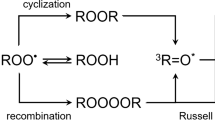Abstract
This study focuses on the characterization of bacterial and yeast species through their autofluorescence spectra. Lactic acid bacteria (Lactobacillus sp.), and yeast (Saccharomyces sp.) were cultured under controlled conditions and studied for variations in their autofluorescence, particularly in the area representative of tryptophan residues of proteins. The emission and excitation spectra clearly reveal that bacterial and yeast species can be differentiated by their intrinsic fluorescence with UV excitation. The possibility of differentiation between different strains of Saccharomyces yeast was also studied, with clear differences observed for selected strains. The study shows that fluorescence can be successfully used to differentiate between yeast and bacteria and between different yeast species, through the identification of spectroscopic fingerprints, without the need for fluorescent staining.





Similar content being viewed by others
References
Amiel C, Mariey L, Curk-Daubie M-C, Pichon P, Travert J (2000) Potentiality of Fourier transform infrared spectroscopy (FTIR) for discrimination and identification of dairy lactic acid bacteria. Lait 80:445–459
Barnett JA, Payne RW, Yarrow D (1990) Yeasts: characteristics and identification, 2nd edn. Cambridge Univ. Press, Cambridge
Bayrock D, Ingledew WM (2001) Changes in steady state on introduction of a Lactobacillus contaminant to a continuous culture ethanol fermentation. J Ind Microbiol Biotechnol 27:39–45
Berthier F, Ehrlich SD (1998) Rapid species identification within two groups of closely related lactobacilli using PCR primers that target the 16S/23S rRNA spacer region. FEMS Microbiol Lett 161:97–106
Davis JG, McLachlan T (1974) Yogurt in the United Kingdom: chemical and microbiological analysis. Dairy Ind 39:149–177
Edwards CG, Reynolds AG, Rodriguez AV, Semon MJ, Mills JM (1999) Implication of acetic acid in the induction of slow/stuck grape juice fermentations and inhibition of yeast by Lactobacillus sp. Am J Enol Vitic 50:204–210
Giana HE, Silveira L Jr, Zangaro RA, Pacheco MTT (2003) Rapid identification of bacterial species by fluorescence spectroscopy and classification through principal components analysis. J Fluoresc 13:489–493
Gunasekera TS, Attfield PV, Veal DA (2000) A flow cytometry method for rapid detection and enumeration of total bacteria in milk. Appl Environ Microbiol 66:1228–1232
Ivnitski D, Abdel-Hamid I, Atanasov P, Wilkins E (1999) Biosensors for detection of pathogenic bacteria. Biosens Bioelectron 14:599–624
Jolliffe I (2002) Principle component analysis, 2nd edn. Springer series in statistics. Springer, Berlin Heidelberg New York
Kirschner C, Maquelin K, Pina P, Ngo Thi NA, Choo-Smith LP, Sockalingum GD, Sandt C, Ami D, Orsini F, Doglia SM, Allouch P, Mainfait M, Puppels GJ, Naumann D (2001) Classification and identification of enterococci: a comparative phenotypic, genotypic, and vibrational spectroscopic study. J Clin Microbiol 39:1763–1770
Kosse D, Ostenrieder I, Seiler H, Scherer S (1998) Rapid detection and identification of yeasts in yogurt using fluorescently labeled oligonucleotide probes. Int Dairy Fed spec issue 9801:132–137
Lakowicz JR (1999) Principles of fluorescence spectroscopy, 2nd edn. Kluwer Academic/Plenum Publishers, New York
Leblanc L, Dufour E (2002) Monitoring the identity of bacteria using their intrinsic fluorescence. FEMS Microbiol Lett 211:147–153
Lefier D, Lamprell H, Mazerolles G (2000) Evolution of Lactococcus strains during ripening in Brie cheese using Fourier transform infrared spectroscopy. Lait 80:247–254
Lehninger AL, Nelson DL, Cox MM (1993) Principles of biochemistry, 2nd edn. Worth Publishers, New York
Lewis JG, Learmonth RP, Attifield PV, Watson K (1997) Stress co-tolerance and trehalose content in baking strains of Saccharomyces cerevisiae. J Ind Microbiol Biotech 18:30–36
Liu SQ, Holland R, Crow VL (2004) Esters and their biosynthesis in fermented dairy products: a review. Int Dairy J 14:923–945
Lonvaud-Funel A (1999) Lactic acid bacteria in the quality improvement and depreciation of wine. Antonie Van Leeuwenhoek 76:317–331
Van Reenen CA, Dicks LM (1996) Evaluation of numerical analysis of random amplified polymorphic DNA (RAPD)-PCR as a method to differentiate Lactobacillus plantarum and Lactobacillus pentosus. Curr Microbiol 32:183–187
Acknowledgements
The authors would like to acknowledge the support of grants from the Australian Research Council and the National Health and Medical Research Council Research Network for Fluorescence Applications in Biotechnology and Life Sciences (RN0460002), Macquarie University Research & Development Scheme, and the University of Southern Queensland Centre for Rural & Environmental Biotechnology.
Author information
Authors and Affiliations
Corresponding author
Rights and permissions
About this article
Cite this article
Bhatta, H., Goldys, E.M. & Learmonth, R.P. Use of fluorescence spectroscopy to differentiate yeast and bacterial cells. Appl Microbiol Biotechnol 71, 121–126 (2006). https://doi.org/10.1007/s00253-005-0309-y
Received:
Revised:
Accepted:
Published:
Issue Date:
DOI: https://doi.org/10.1007/s00253-005-0309-y




